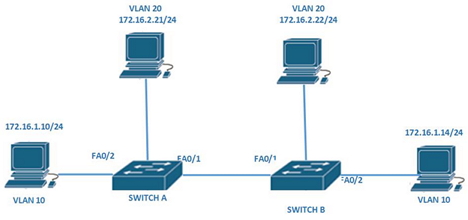As Cisco revamped the Cisco CCNA 200-120 exam a few months ago, one of the things we have seen is Cisco has put an increased emphasis on the ability for the CCNA candidate to really troubleshoot a network. As you compare the CCNA exam objectives from the old version of the CCNA exam to the new version of the exam you may not see a whole lot of major changes to the topics that are covered. But what you will see is how Cisco increased the difficulty of the questions that are on the CCNA exam.
Let’s look at a sample question that you might find on the new CCENT & CCNA exams. The first thing you will note that our sample CCNA 200-120 scenario question has both a topology diagram and a show a bunch of information in the form of a show interface trunk output on both switches. Cisco takes this opportunity to overwhelm you with too much information. That will cause some students to freeze up the first time they see this. This is where the students with real hands on lab experience will be able to lean on their CCENT & CCNA lab experience to help absorb all the information. So here is our sample exam question.


A network administrator is diagnosing a switched network when he realizes that a frame from VLAN10 of switchA is sent to switchB where the frame received on VLAN20. What causes this behavior
A. Trunk mode mismatches
B. VLANs that do not correspond to a unique IP subnet
C. Allowing only VLAN 20 on the destination.
D. Native VLAN mismatches
E. VLAN 10 is not allowed on switch
Caution Answer Below CCENT and CCNA Logos!

The correct answer is D – Native VLAN mismatches.
Detailed Explanation
A trunk is a point-to-point link between two network devices that carries more than one VLAN. A VLAN trunk allows you to extend the VLANs across an entire network. The native VLAN carries all untagged traffic between switches, the VLAN trunk does not belong to any VLAN rather, it serves as a highway between different switches and routers on the network.
This questions tries to examine the learner’s understanding of VLANs, switchport trunk and the native VLAN.
a) In this question answer A is wrong since the status on both interfaces interconnecting the switches are in trunking mode.
b) Answer B is wrong since each VLAN is supposed to be on its own unique subnet and this is the case in this scenario.
c) Answer C and E are wrong since all Vlans are allowed across the trunk link.
d) D is the correct answer, SwitchA is configured with Vlan 10 as the native while SwitchB is configured with VLAN20 as the native vlan.
Native VLAN mismatches can bring about error messages as well as misdirected traffic which is the case in this scenario.
Now as a comparison, let’s look at an example of a question that was on an older version of the CCENT or CCNA exam pertaining to VLANs and trunking is as follows:
Which is a Cisco proprietary protocol that maintains VLAN information within the Ethernet frame.
A. 802.1Q
B. VTP
C. ISL
D. 802.1X
That is a pretty straight forward question that you simply have to memorize ISL is the Cisco proprietary protocol and 802.1Q is the IEEE specified standard. Beyond some simple memorization, the student did not have to really think hard about the questions and if they did not know, the student probably had a 50-50 chance by eliminating some answers that they know are incorrect. I think you can clearly see how Cisco has made the CCNA exam much harder without having to majorly alter the exam topics. This example should also help you better understand why actually having your own labs and being able to practice these types of scenarios is the best way to help you prepare for your CCENT and CCNA exams.
But most important is having your own CCENT / CCNA lab which will allow you to have the real hands-on experience that hiring managers are looking for when they hire their entry level admins. Ask yourself if you were a hiring manager and you had the choice between two CCNA certified associates. One is a paper CCNA who never opened a router and did memory upgrades or installed and configured any Cisco modules. The other is one who memorized the exam answers and maybe even used a CCNA simulator that we know does not support all the features of a real Cisco router or switch. Which one would you pick?
So if you are interested in how to build a lab then simply click here for an overview on How to Build a CCNA Lab.
